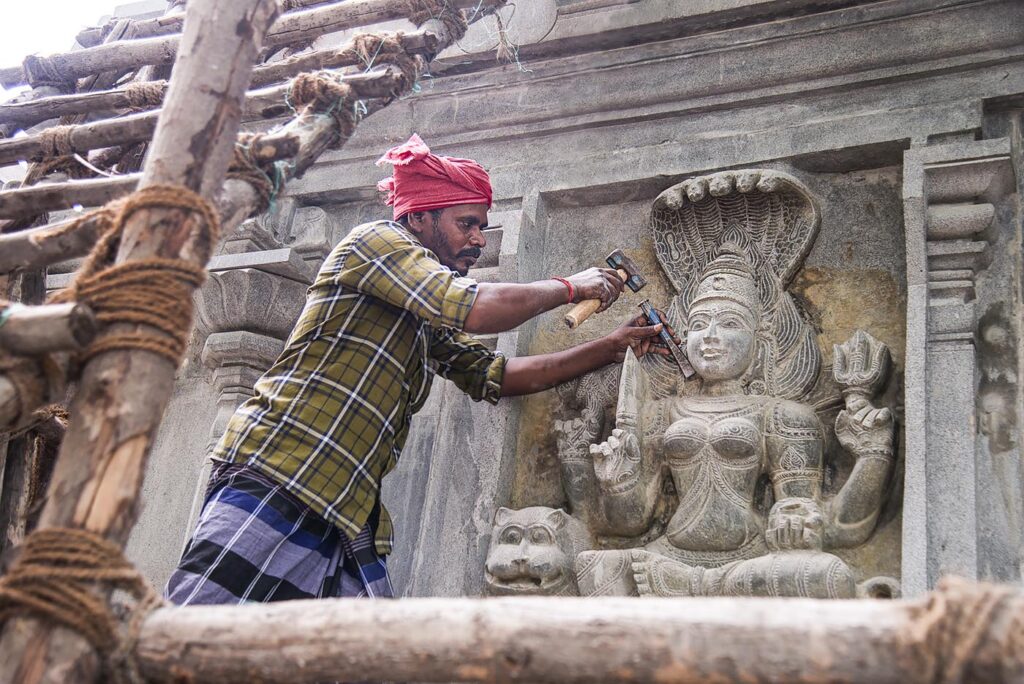India’s ancient crafts, thriving to this day, tell awe-inspiring tales of human creativity and religious fervor. Stone etching, metal casting, wood carving, earth molding and primordial musical instruments—let’s experience the living stories of these five arts with traditional exponents in Tamil Nadu.
Text by Padma Krishnan, Photos by Anne Petry
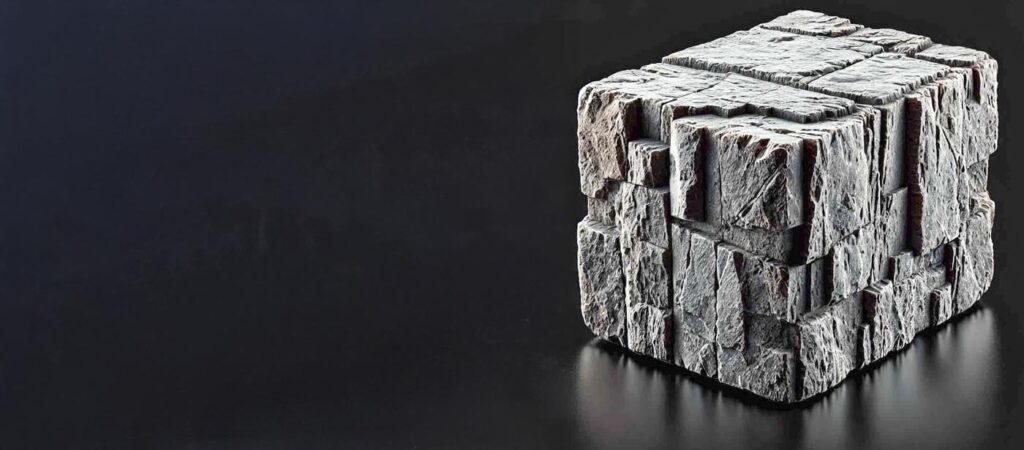
STONE
In the annals of history, when our ancestors wanted to express themselves, they turned to the most enduring medium available to them: stone. From primitive cave paintings, early humans progressed to carving. They chose stones for their exceptional durability, a choice that has preserved their contributions to our shared heritage for millennia.
In the rich mosaic of India, stone carving gave rise to magnificent temple architecture that stands as a testament to the ingenuity and devotion of its diverse population. Marvels such as the Kailasanatha Temple in Ellora, the Khajuraho Temples in Madhya Pradesh and the Brihadeeswara Temple in Thanjavur are not mere structures. They are living narratives, frozen in stone. India is also home to many stone astronomical observatories. The Jaipur observatory, built in the 1700s, has the largest sundial in the world and is still functional.
India’s vast landscape offers a wide variety of stone for artisans to create timeless magic. In the state of Rajasthan, marble takes center stage, giving rise to the renowned latticework seen in the Dilwara Jain Temples on Mount Abu. Agra and Rajasthan have been hubs of marble inlaid work since the sixteenth century. In the southern states of Tamil Nadu, Karnataka and Andhra Pradesh, abundant granite has given birth to magnificent temple complexes such as the Meenakshi Temple in Madurai, Nellaiappar in Tirunelveli and the rock-cut structures of Mahabalipuram, adorned with grand pillars and colossal monolithic statues. Similarly, the availability of basalt in Telangana played a pivotal role in the creation of the exquisite sculptures at the Ramappa Temple.
While the awe-inspiring cathedrals of the West continue to enthrall us to this day, the craftsmanship that created these magnificent structures has dwindled. In India, however, ancient art and craft forms show historical continuity even now, since they are intertwined with living religious practices. The stone sculptors, carving Deities and temples, preserve their rich heritage as a sacred duty. As Hinduism spreads beyond the borders of India, stone artisans take their traditional skills to construct Chola-style temples in faraway places like Hawaii.

The traditional sculptor of today follows the same rules that governed the massive temples built during the eras of the Cholas, the Pandyas or the Chalukyas. He uses similar tools as the sculptors of the past—the hammer and chisel. The master carver intuitively wields his chisel and hammer, forgoing the use of machine tools in the final stages of carving a Deity. So immersed does he get, that the Deity he is carving lets itself be known to him at times. One of the artists we spoke to for this article, Shiva, said he had the experience of the Divine Mother when he was carving the head of Amman. The dedication of such workers channels the prapancha shakti, cosmic energy, into the murti, making it accessible to the devotees who visit the temples.
Four Stages of Deity Sculpting
The sculpting of Deity murtis is done in stages. Stone murtis are expected to last for 3,000 years, so sculptors pay close attention to each step, mindful of their legacy. Stone carving is a physically and mentally demanding craft. Even the slightest error can render an entire work futile, resulting in the loss of valuable resources and labor.
Selecting a stone: Carvers select stones according to the size of the murti and the quality of the stone. They use traditional methods such as visual inspection, sound and water tests to identify the best stones. Stones that make a clear sound when struck and do not leave watermarks when wetted are best suited for carving Deities. Watermarks indicate hidden cracks, and the stone will break easily during the carving or soon after. In Tamil Nadu, stone carvers divide the rocks into three types: male, female and neutral. Female stones are good for carving a Deity because they are pliable and hold the form of the image well. Once a suitable rock is identified in a quarry, it is cut to the desired size and transported. In olden days, a puja was performed before cutting the rock, so that the broken piece would retain its life energy.
Carving: Carving Deities is a complex and time-consuming process. As a first step, the rock is soaked in water for a few days to soften it. A puja is performed to seek the blessings of the intended God or Goddess. Then, the sculptor draws the image of the Deity on the stone from memory, based on ancient texts. Most craftsmen today use power tools to carve the rough shape of the murti, but the finer details are always chiseled by hand.
Treating: After the image of the Deity is carved completely, the murti is rubbed with sesame oil to give it a sheen. A mixture of burnt coconut shell and sesame oil is applied for darker shades. The Deity’s eyes are of great significance. They are covered with a cloth until the kumbhabhishekam and revealed only after the murti’s consecration in the temple.
Consecration: When the murti reaches the temple, it is installed after an elaborate puja. Traditionally, it is immersed in water, grains and coins for 48 days before the kumbhabhishekam. If the murti is a replacement for a broken one, the energy from the previous murti is transferred to a miniature replica made of fig wood. The replica remains energized through mantra chants and pujas until the replacement is installed.
During the creative processes, the master carver is always present. He selects the stone, supervises cutting, relies on his memory to sketch the image and carefully chisels to reveal the hidden God. Stonework requires a multitude of skills. Sculptors must have a very clear sense of scale and proportion, as well as knowledge of mythology and iconography. Each Hindu God is worshiped in myriad forms, and a sculptor needs to know each of those forms in detail.
Ancient stone carvers demonstrated their skills by building massive pillars, extensive temple complexes and exquisite murtis. One can see their amazing artwork on the roofs and pillars at the big temples in Madurai, Tiruvannamalai, Chidambaram, Thiruvarur, Thiruvakkarai, Tiruvarangu and Tirunelveli. Each of these temples features grand halls known as Ayiram Kaal Mandapam (“thousand-legged hall”) characterized by their thousand-pillared design. The pillars depict mythological stories and the everyday lives of common people. They also effectively control the noise level.
Stones that Sing
The skill of ancient stone sculptors was such that they could make stones sing. Yes, a talented sculptor could choose the right type of stone and carve it in such a way that the stone pillars would resonate with melodious notes when struck. We can listen to musical pillars at temples in Thiruperunthurai, Suchindram, Tirunelveli and Alwarthirunagari in Tamil Nadu, as well as in Hampi, Karnataka and Lepakshi, Telangana. They amaze visitors with classical Indian musical notes centuries after their construction. In olden days musicians would tune their instruments using these pillars.
Monolithic Marvels
India boasts colossal statues and temples carved from single rocks and mountains across the country. The Kailasanatha Temple at Ellora Caves, carved from a single cliff rock approximately 1,200 years ago, stands as an architectural marvel. Similarly, the Masroor rock-cut temples in Himachal Pradesh, known as the Ellora of Himachal, are monolithic temples. They are dedicated to Shiva, Vishnu, Brahma, Durga and the Sun.
The state of Karnataka is home to five massive monolithic statues of Jain Tirthankara Bahubali, including the colossal 57-foot Gomateshwara at Shravanabelagola. This granite monolith was among the tallest statues in the ancient world. Madhya Pradesh’s Bawangaja features the world’s second-largest monolithic statue, of Lord Rishabhadeva, carved from a mountain in the 12th century. It still stands tall at 84 feet.
The expertise in carving massive monoliths persists even today. Recently, a 35-foot-tall Hanuman statue was carved from a single stone in Allagadda, Andhra Pradesh, and transported to the Seetha Ramasamy Temple in Kerala. Another colossal monolith was sculpted in Tamil Nadu—an impressive 64-foot-high statue of Vishwaroopa Maha Vishnu. This mammoth creation, weighing a staggering 300 tons, was installed in the Kothandaramaswamy Temple in Bengaluru. These contemporary marvels serve as compelling evidence of the historic continuity of the talent for carving monoliths.
The knowledge and skills are conventionally passed down through male members of artisan families. While the next generation of a traditional artisan family may opt for different professions, many educational institutions now offer professional courses in traditional crafts, infusing new talent into these ancient vocations. It is worth noting that students often continue their training under traditional sculptors to refine their craft.
The growing interest in handcrafted artifacts has increased the demand for stone-carved objects for decor and cookware. The handicrafts industry is a major employment generator in the unorganized sector in India, and Indian handicrafts are sought globally. Religious festivals like Navaratri, Ganesha Chaturthi and Diwali keep the ancient crafts alive, as people buy murtis, dolls and lamps to celebrate. Additionally, a steady demand for artists like Shiva is maintained by the construction of temples worldwide and the restoration of temples in India. These artisans will continue to play a pivotal role in making the formless Divine accessible and relatable to devotees in the years to come, much like their stone-carving predecessors did thousands of years ago.
Phases of Manifestation

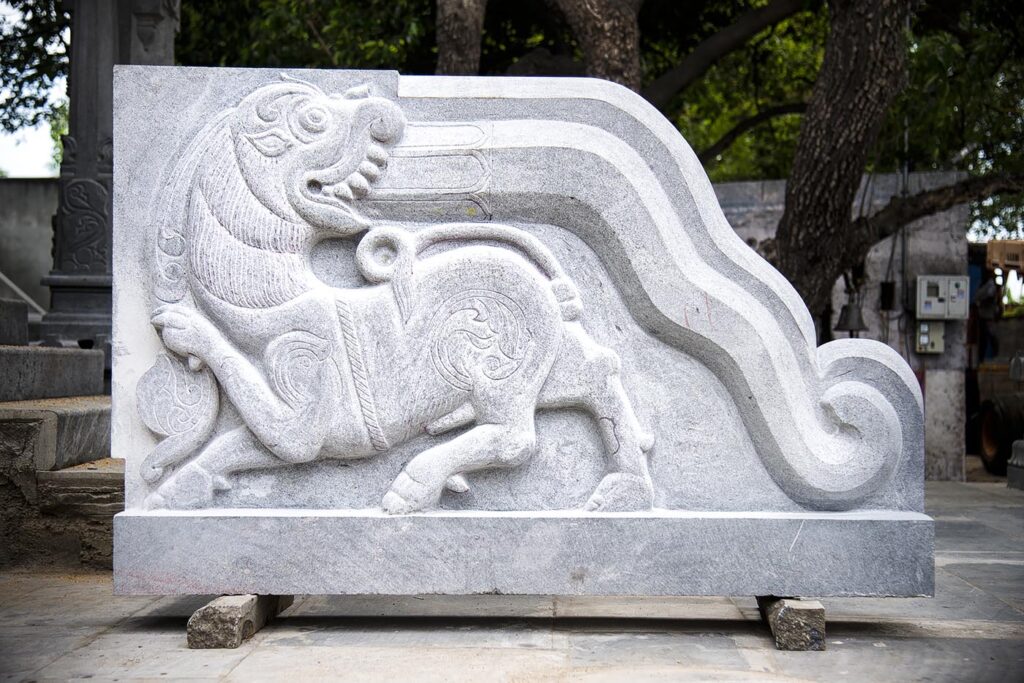
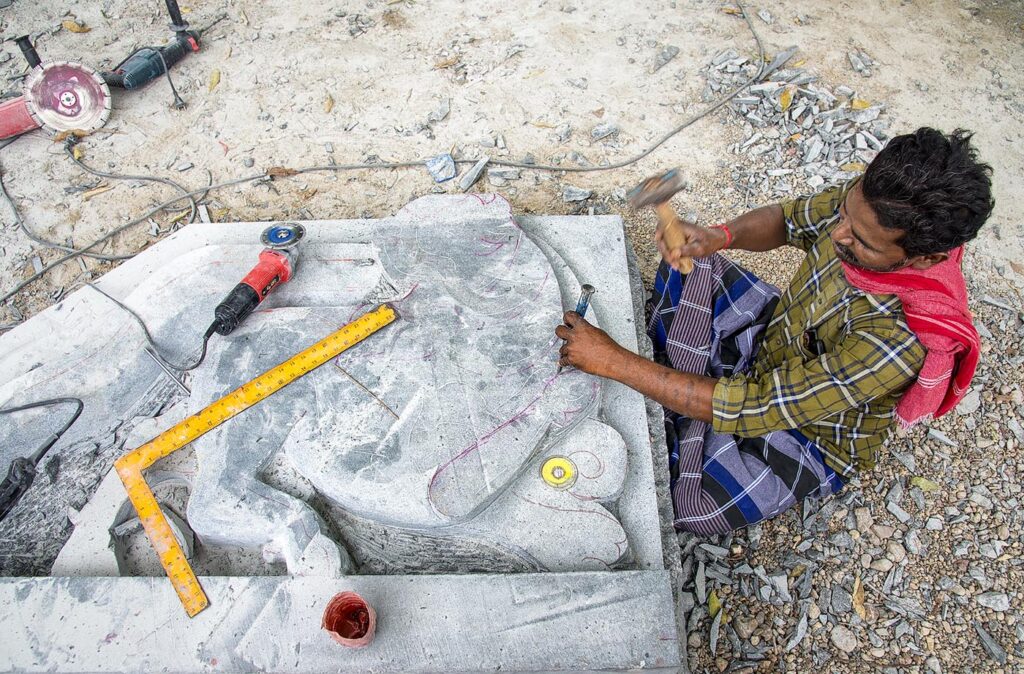
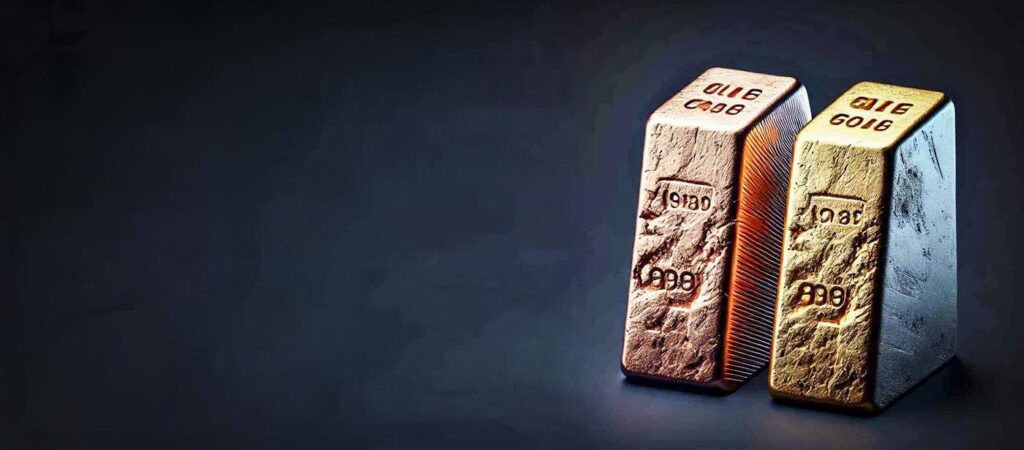
METAL
India’s legacy of metalwork goes back to 3,000 bce, evident from the handcrafted relics found across the subcontinent, such as the “dancing girl” statue of the Indus Valley civilization. That renowned bronze figure showcases early mastery in the lost-wax method, still practiced by Indian artisans. In the centuries that followed, metalsmiths crafted the Iron Pillar of Delhi, nicknamed “rustless wonder.” This 1600-year-old sentinel continues to intrigue experts for its remarkable resistance to rust.
Beyond its mastery of iron, ancient India also excelled in the production and export of steel. From the crucibles of South India, Wootz Steel was forged. Wootz—derived from Tamil “uruku” or “ukku”—formed the crucial raw material for the legendary Damascus swords.
Indians were also skilled in creating alloys. Bronze, an blend of copper and tin, has been used widely for centuries in religious metalwork. Ancient texts mention the precise composition to create panchaloha, or panchdhatu—a mix of five metals: gold, silver, copper, zinc and iron. Another alloy, ashtadhatu, mixes eight metals: gold, silver, copper, zinc, lead, tin, iron and mercury. Each metal is associated with a positive quality—gold with purity, iron with courage, etc. Gold and silver were once used to craft grand chariots.
Swamimalai, the Hill of God
Bronze casting, once widespread across the Tamil region, is now practiced only in Kumbakonam and nearby Swamimalai, and a few centers around Cuddalore and Thanjavur. Swamimalai, now the heart of this ancient craft, has become synonymous with bronze icons. The town lies on the banks of the Kaveri River where, according to mythology, the primordial sound Om was revealed to Lord Siva by His precocious son Lord Murugan. Swamimalai is also one of Murugan’s six abodes.
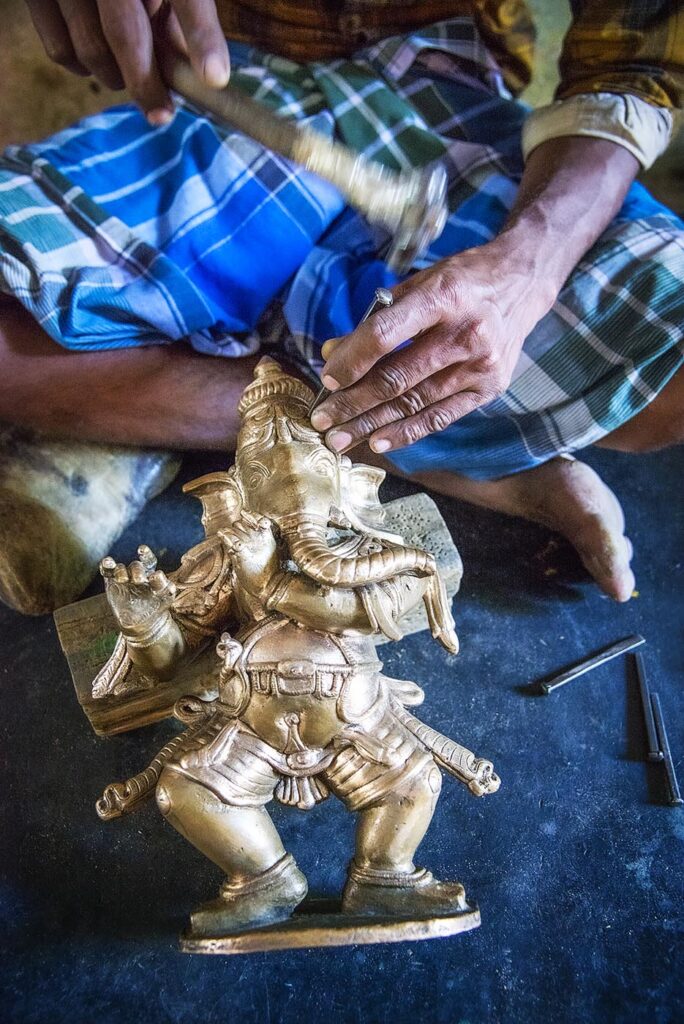
Here, the rhythmic clangs of metals take us back to the 9th century, when the great Cholas ruled. During their long reign (9th to 13th century), art and culture thrived. They built marvelous temples, many which—like the Thanjavur Brihadeeswara Temple—are still functioning. Bronzesmiths gathered to forge murtis and paraphernalia for the great temples at the behest of Chola rulers like King Raja Raja, King Rajendra and Queen Sembiyan Mahadevi. Drawn by the continuous patronage of royalty, alluvial sand and weather suitable for their creations, the artisans settled near rivers. Through the centuries, they stood as sentinels, guarding a legacy that has outlived kingdoms. The locals proudly say, “Our art is as old as the holy mountain.”
The seed of the marvelous bronze creations is a wax image of the desired icon. In the past, this was created from beeswax; nowadays a mixture of resin and wax is used. The Shilpa Shastras mention a lost-wax method. The wax model is coated with clay, forming a mold known as a karu, or “womb.” This mold is strengthened with charred husk, salt, cotton and metal wires before being left to dry in the sun.
In the next stage, metal for the murti is melted to 1200 degrees Celsius in a crucible fueled with firewood and briquettes of cow and goat dung. The wax is melted and drained from the mold, and skilled bronze casters, pour the lava-like metals manually into the empty mold. The metal takes shape as it fills the mold. After cooling, the clay mold is broken to retrieve the rough bronze murti. It is then cleaned using the ashes from the fire.
Finer features, expressions and ornaments are chiseled by hand. The eyes (netra) are carved in the last stage; the murti becomes sacred and revered after the “netra (eyes) opening” ceremony. Born of fire, sweat and sound, the murtis are finally mounted on ornate platforms. A puja is performed before the icons leave the workshops.
The Swamimalai sthapatis emphasize the uniqueness of their craft. It is single casting and the entire icon is done once, unlike the Moradabad method, where molds are reused, arms and legs are cast separately and brazed together. Craftsman Suresh Subramanian says, “Using my knowledge and creativity to bring a smile to my customers’ faces, and seeing their satisfaction once they have the statue in their hands, is something extremely gratifying and joyful for me.”
The laborious and dangerous process takes weeks to years, depending on the size and complexity of the murti. Temple murtis are proportional to the size of the temple and the chief icon, mulavar. The murtis are usually solid, but the vahanams, like Nandi or Lion, and chariots are hollow.
Changes through Time
The ancient craft, passed down through millennia, has undergone transformations with time. Long ago, sthapatis paraded their wax models through villages, their artistry judged by the community before committing to precious metal. Such rigorous critique, no longer practiced, minimized waste and ensured adherence to tradition. Similarly, mud from anthills and earth gored by elephants or pigs, earlier chosen for its texture and symbolic purity, has given way to faster-drying, cheaper plaster molds. The fire in the furnaces, too, is changing from wood-fire to gas and oil. But the murtis cast for worship in temples and homes are still molded in beeswax-resin mix and alluvial soil.
Coconut leaflets, marked in the “Thala” system (head-to-chin distance), served as traditional measurements. Some sthapatis now use tapes, but ancient iconography and proportions remain sacred.
Swamimalai’s artisans carry their icons to the state capital for export certification from the ASI (Archeological Survey of India) officials, who visit from the national capital monthly. Meant to safeguard antiques, this process has become a deterrent to patrons and a burden to the artisans, causing unnecessary delays, cost escalation and even lost orders. They have been asking for a local center for certification for years to ease foreign trade.
Iconic Murtis
The Chola rulers were ardent devotees of Siva. Saivism flourished during their long and glorious rule; they built numerous temples and patronized artisans and poets celebrating Saivism. Inspired by the imagery of bhakti poems and royal support, early Chola metalwork primarily focused on Siva murtis, later expanding to include icons of Devi, Ganesh and Murugan.
Dancing Siva, Nataraja, became a popular motif, alongside sculptures of Saivite poets. A rare depiction shows Siva as Bhikshatana, the naked beggar. Subtle stylistic shifts emerged over time. Early icons featured minimal decoration, while later periods embraced intricate ornaments and detailed clothing. As Vaishnavism gained favor, Vishnu, Lakshmi and Krishna icons were cast; but Nataraja and Ardhanarishwara retained their dominance.
Facing the Future
This ancient craft is facing a trifecta of challenges: price rises, cheap imitations and changes in personalized worship. Once a cornerstone of faith, personalized murti worship grapples with societal transformations. A friend recently mused about the fate of the murti of Krishna her mother worships fervently in the bhakti tradition. The Lord is fed, bathed and dressed in splendor and put to sleep with songs at night. My friend and other members of her family have gravitated towards a non-ritualistic path and would never care for their family icon as their mother does, after her. While old murtis might find another worshiper, one might ponder how future generations will uphold the individualized forms of murti worship. Meanwhile, murtis of Deities have become popular as decorative props. This drives demand, but some artisans feel this belittles their sacred art, which is rooted in worship.
Increasing prices of metals have depressed local demand, and cheaper machine-made imitations further challenge Indian handicrafts in the international market. Geographical Indication tags are a big boost. They also offer protection from imitations, and help artisans form cooperative collectives to train, build awareness and raise capital.
NGOs and government initiatives foster market expansion and introduce technological innovations to scale. However, ensuring that this growth doesn’t erode the distinct value of traditional craftsmanship remains crucial for the survival of craft and its artisans.
Despite the challenges, artisans are keeping their artistry alive. Our interviews with metalsmiths revealed a profound sense of responsibility and commitment to ensure their timeless handiwork continues to inspire generations to come. Non-hereditary workers share this dedication. All are united by a profound appreciation for the opportunity to leave an enduring legacy. This sense of sacred duty makes them resolute in preserving their craft. As one said poetically, “India is art; art is India. As long as we are here, art will be there. As long as art is there, India will be there.” Their craft, forged in fire and molded in soil, is engraved in their souls and the soul of their land. Hopefully, it will survive the age of AI, 3D printing and lunar mining.
From wax to cast bronze
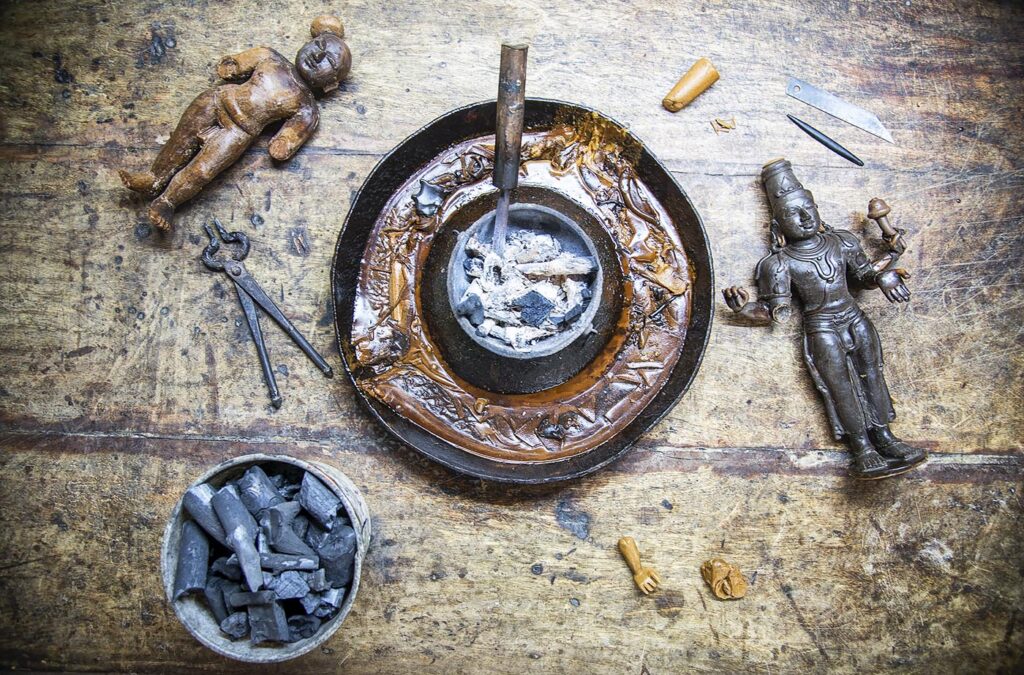
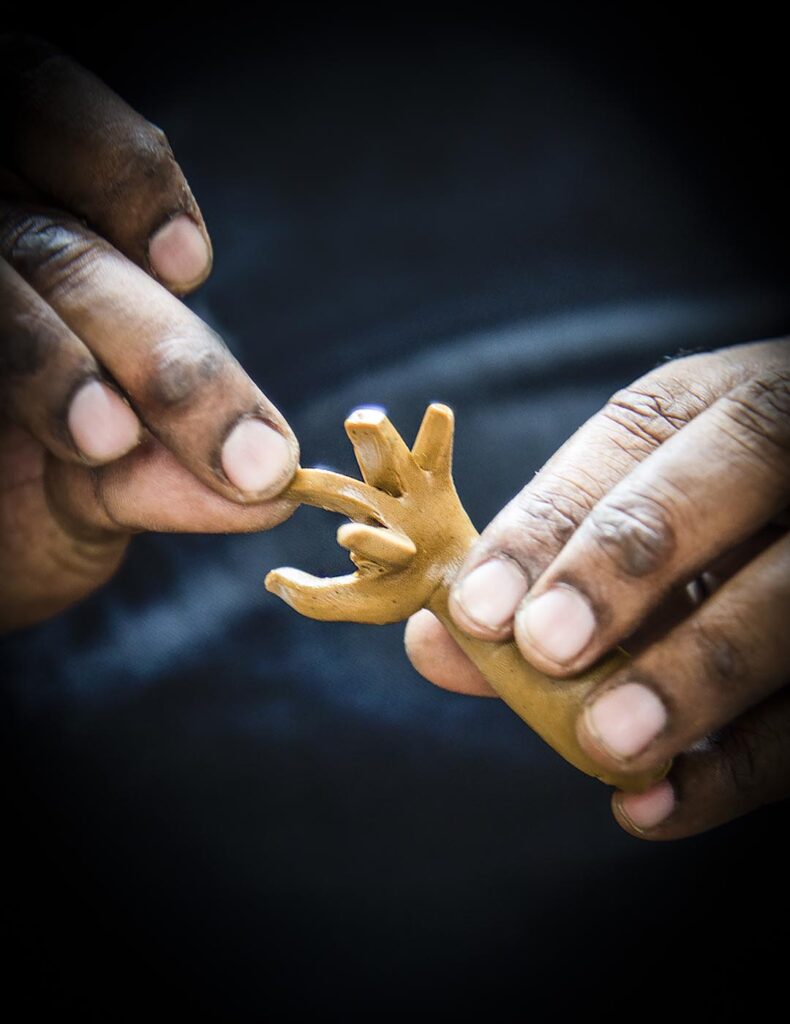
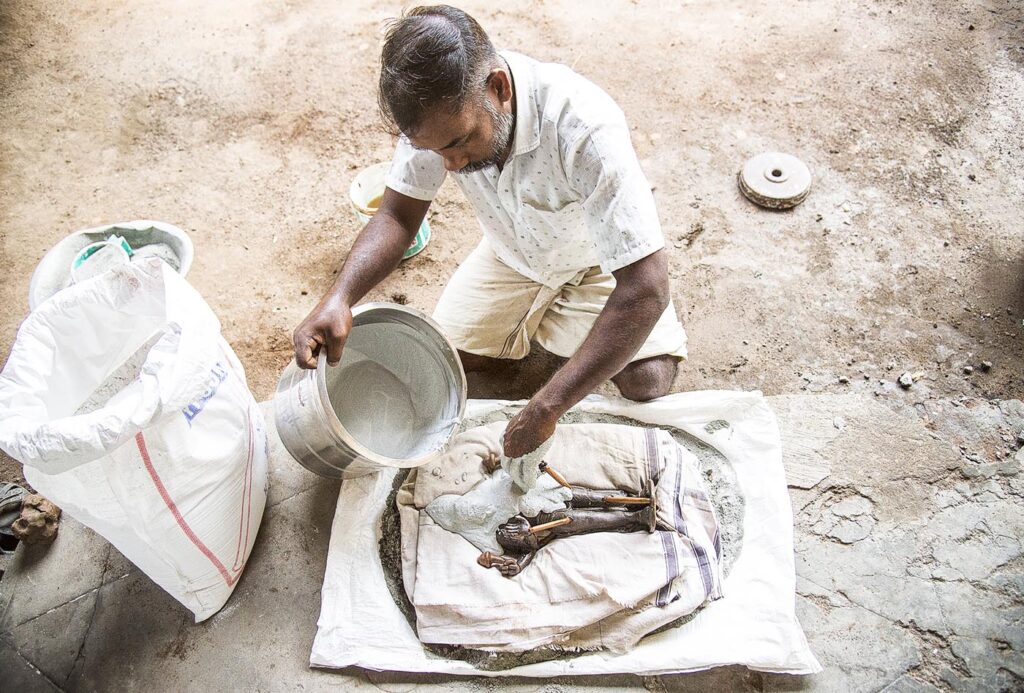
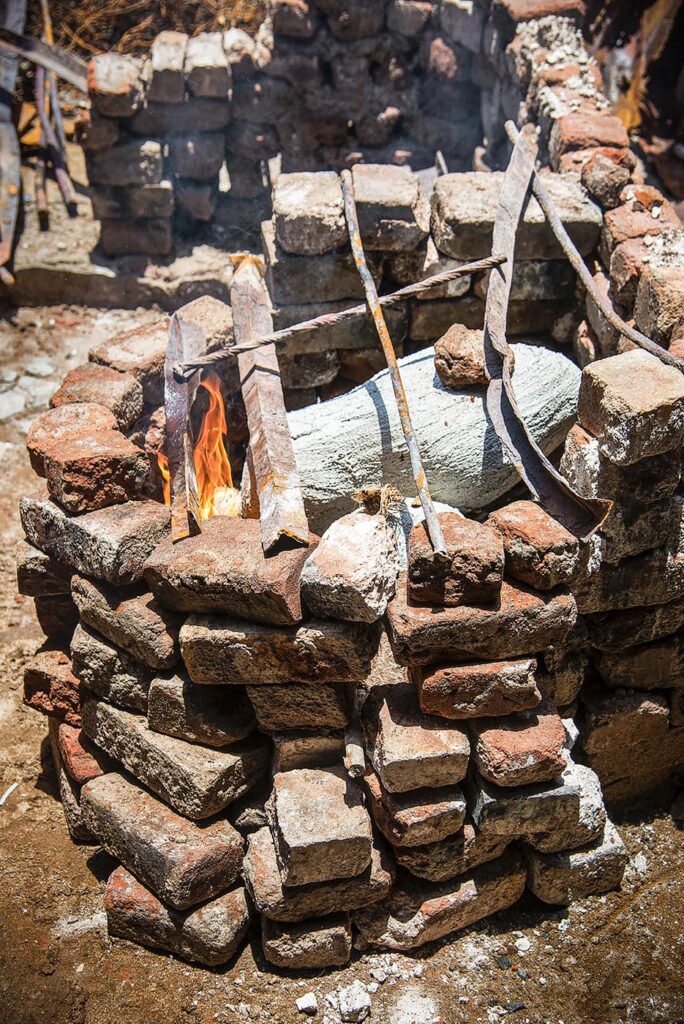
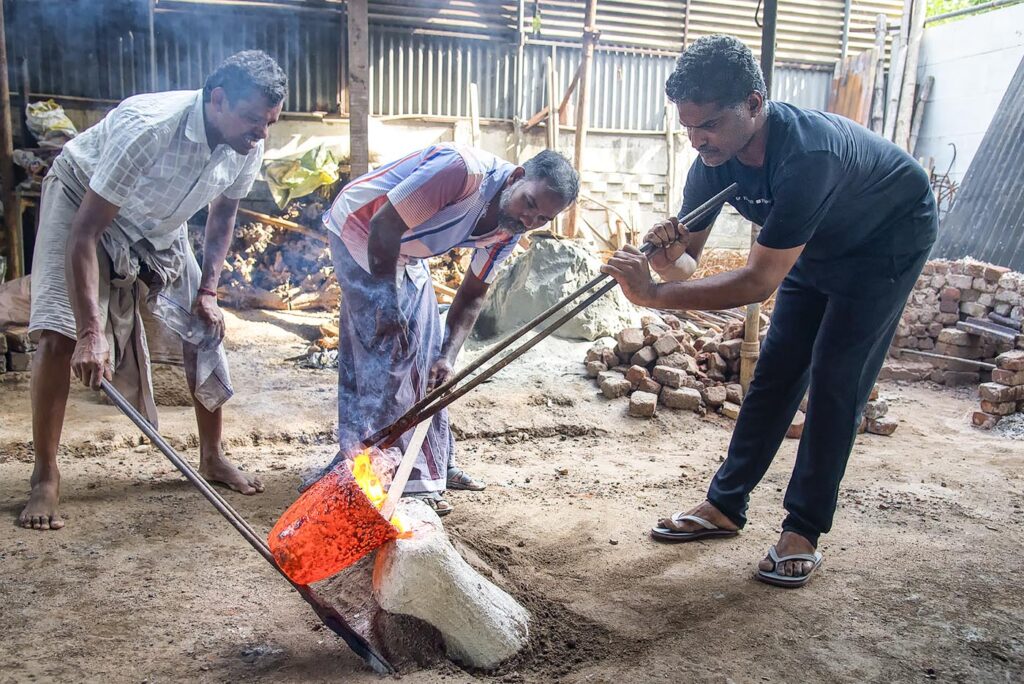
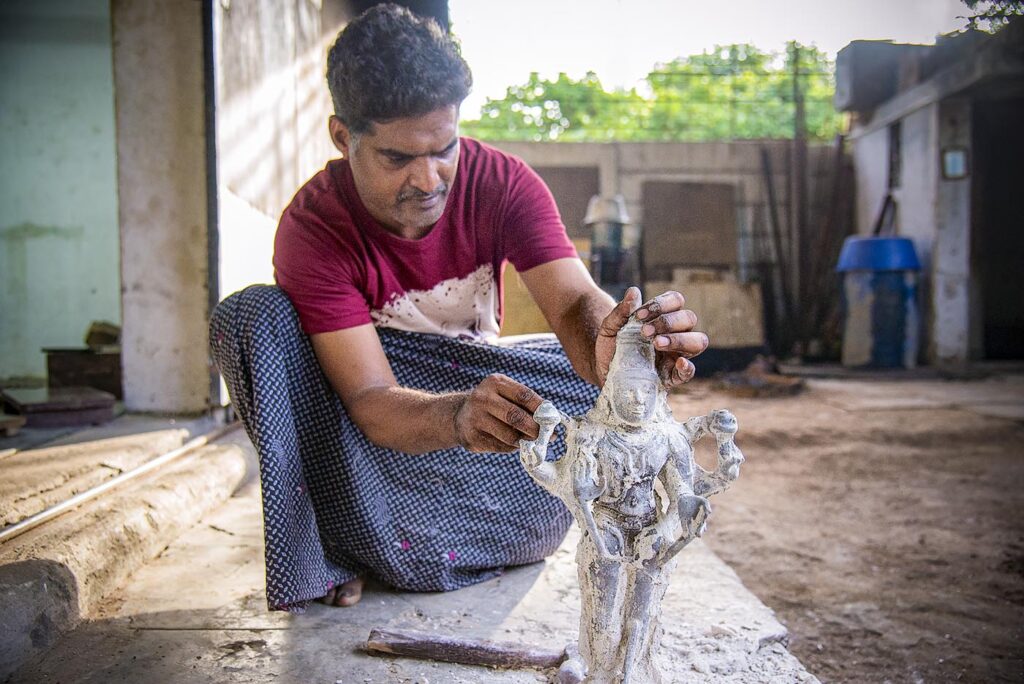
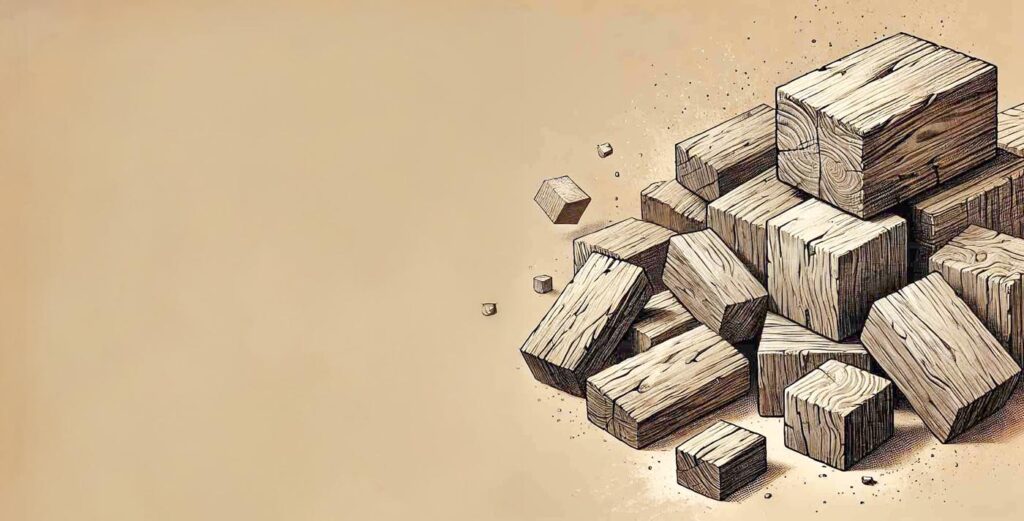
WOOD
In india, trees are held in deep reverence, believed to be the abode of divine beings. Sacred groves, once an essential part of every village, served as sanctuaries for old trees. Ancient temples often feature a sthala vriksham, a tree where a sage meditated or where a Deity first appeared. These trees are diligently protected, embodying the profound connection between India’s geography, religious traditions and spirituality.
This reverence for trees has naturally permeated India’s rich heritage of wood carving. The time-honored craft has evolved over centuries, shaped by the type of timber available and the influence of diverse cultures. This has resulted in a rich tapestry of regional styles and techniques. From the intricate artistry of Rajasthan to the life-sized sculptures of Tamil Nadu and ornate walnut carvings of Kashmir, each timber narrates a unique regional saga.
Ancient Lineage
Hereditary woodcarvers in India trace their lineage to the divine architect Vishwakarma, who is invoked at the commencement of carving Deities, chariots and other sacred relics and in the construction of homes. Familial skills are passed down through generations, in workshops laden with sawdust and chips. Artisan Subarayan, whom we interviewed for this article, recalls how his training commenced when he was around seven. He and boys his age from his family learned about tools, trees and carving during the day and dedicated their evenings to learning to draw. He laments that the ubiquity of cameras has led to a drastic reduction in the time people spend honing their drawing skills these days. As the current generation pursues formal education, the apprenticeship is different nowadays. Even artisans from traditional households embark on their crafting careers at a later age. Unlike stone carving, women participate more actively in creating sacred objects in wood.
Sacred Items
Religious wood carving encompasses a wide range of objects used in worship and temple festivals. From grand temple sculptures to delicate figurines of Deities, chariots, exquisitely carved personal shrines and vehicles for the Deities, the artisans’ hard work is visible in many forms and shapes.
Carved doors stand sentinel at temple entrances, holding images of Deities and celestial events on their sturdy frames. These huge doors are not mere entrances but portals into realms where mythology and reality intertwine like vines to create a spiritual resonance with the stone walls and sculptures inside the temple. The massive wooden temple chariots are a marvel in themselves.
Woodwork plays an important role in personal worship in Hinduism. Tied to rituals of murti worship, devotees create dedicated places of worship in their homes with carved wooden platforms, small shrines, personal altars and murtis. In the past, wooden objects were part of everyday life in Indian households. Even today, traditionally constructed houses have images of Gajalakshmi on the top of the wooden frame of doors at the entrance. Sacred symbols, such as the lotus flower, trident and conch, are meticulously carved on the pillars of houses and temples, each symbol carrying spiritual significance.
Carving a Wooden Murti
Woodcarvers possess immense knowledge of native trees handed down through generations of oral transmission. Trees are carefully chosen based on their intended purpose. Commonly used trees include rosewood, teak, monkeypod, neem, jackfruit, sandalwood, walnut and fig, among many others.
A wooden sculpture is created in three stages: rough cut, sculpting and polishing. Sculpting sacred murtis begins auspiciously with a puja performed by the master carver. He seeks the blessings of the intended Deity, as well as Vishwakarma and the family God or Goddess of the client. It’s an acknowledgment of ancient beliefs that the act of creation is sacred.
The rough cut: In the first stage, the rough cut, the log is cut and shaped into the basic form of the intended sculpture. The carver uses chisels, axes, mallets and other tools to remove excess material, revealing the rough contours of the envisioned form. The jadippu process is crucial as it lays the foundation for subsequent stages of carving, where the details and finer features are sculpted. The dhyana sloka of the Deity is chanted during carving to invoke the essence of the Divinity.
Sculpting: As the rough shape emerges, the crafting enters the second stage, the sculpting phase. With gouges, chisels and wooden mallets, the calloused hands of the artisans skillfully create intricate features. A Deity emerges from the wood, not merely as a sculpture but as a vessel of spirituality.
Polishing: In this phase, the murti is chafed to a smooth, polished finish, and then painted if desired. Women contribute significantly to polishing and painting the sculpted murtis. With sandpaper and hand tools they remove the final veil from the timber, and the sculptures come alive, vibrant embodiments of devotion and artistic synergy.
After a puja, the finished sculpture is handed over to the customer. The artisans express gratitude to the Divine for the completion of the work, seek blessings for the new owner and bid adieu to their creation. This ritualistic handing over helps the master carver and his team let go of their creation and relieve their minds from the intense, almost meditative act of carving.
Rethinking the Future
Artisans work in teams, each playing a key role in transforming a block of wood into an object of worship. They can spend a week to six months on a sculpture, depending on its complexity. Small workshops employ up to ten artisans, with wages ranging from us$10 to $18 per day. Some artisans welcome the proliferation of CNC (computer numerical control) machines that reduce costs and increase production. They feel machines can make wooden artifacts affordable to common people. The final detailing, polishing and coating with paint or varnish is always done by hand. Sculptures of Deities meant for worship in temples or at home are fully handcrafted as a sacred duty.
Rampant deforestation has posed a major challenge to the availability of native wood. India now imports wood, causing cost escalation. Despite the challenges faced by traditional crafts in the face of modernization and the loss of native trees, Indian religious woodcraft continues to thrive, thanks to the dedication of skilled artisans and the efforts of preservation initiatives. As one example, the Odisha state government is growing the variety of trees used in building the Jaganath chariot in a special project to meet the annual demand.
Efforts to promote and preserve this craft include fairs, exhibitions and educational programs. The central and state governments award artisans, recognizing their talent. They are huge morale boosters for the craftsmen toiling away in their workshops. Many of them painstakingly work on their masterpieces for months to showcase their talents.
The current generation of woodcarvers is tech savvy and uses digital mediums to sell and market their craft globally. Equipped with smartphones, these youngsters manage basic websites, maintain social media accounts and promptly respond to leads generated through Instagram and Facebook pages. Another avenue is opened through word-of-mouth references within expat communities and instant messaging apps. Passionate woodcarvers share their knowledge and showcase their work via YouTube channels, attracting substantial audiences and generating clientele leads. While smaller murtis and puja artifacts are also sold as decorative pieces on online platforms, personalized Instagram pages appear to attract a larger clientele. Artisan Subarayan’s son Giri Dharan, responsible for their online business, mentions that they achieve more sales through social media postings than through their websites. Video calls and payment gateways have successfully bridged the gap between traditional woodcarvers based in small towns and villages and their patrons in far-flung locations.
Contemporary artists are reinterpreting tradition. They create modern images reflecting current scenarios while retaining the essence of the ancient art form. On the road in India, you might find murtis of Lord Ganesha holding a laptop or wearing glasses. These innovative works find their way into galleries, exhibitions and private collections. They have not yet made it into temples; perhaps in years to come. Keepers of this ancient craft are adapting to a changing world by finding substitute materials, embracing technology and expanding their horizons. The harmonious blend of ancient knowledge and modern thinking keeps the tradition alive.
Hewing revered Deities from blocks of wood
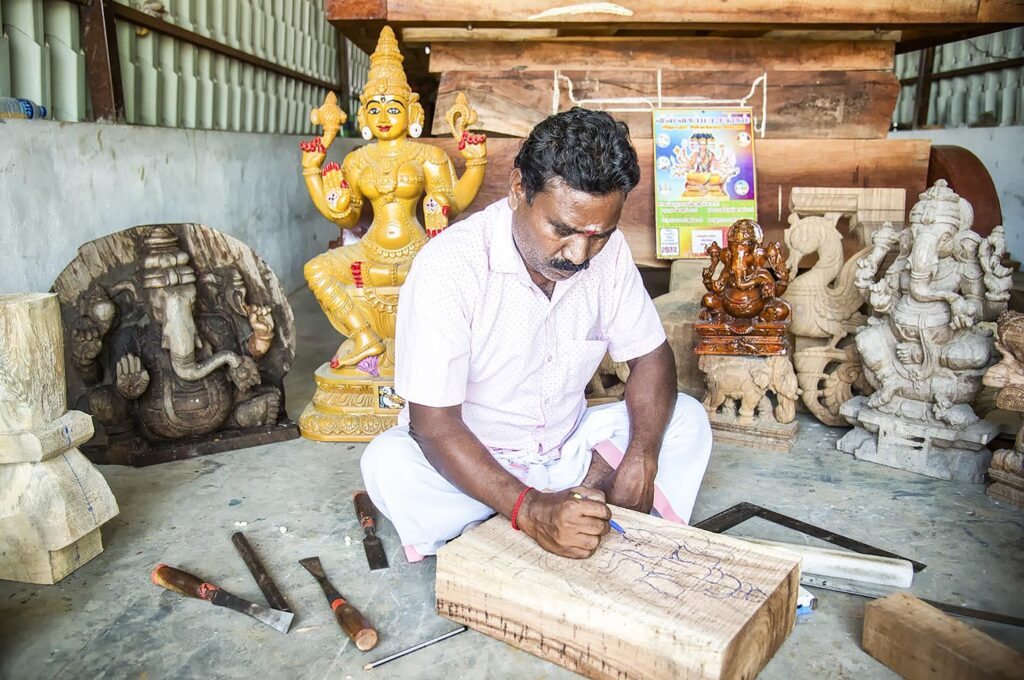
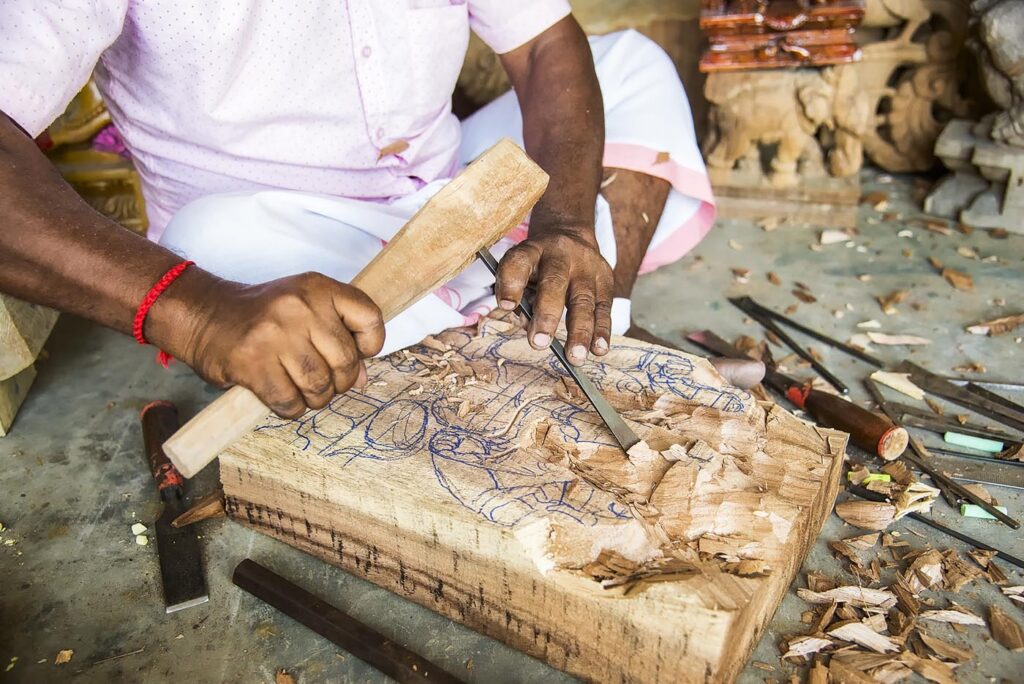
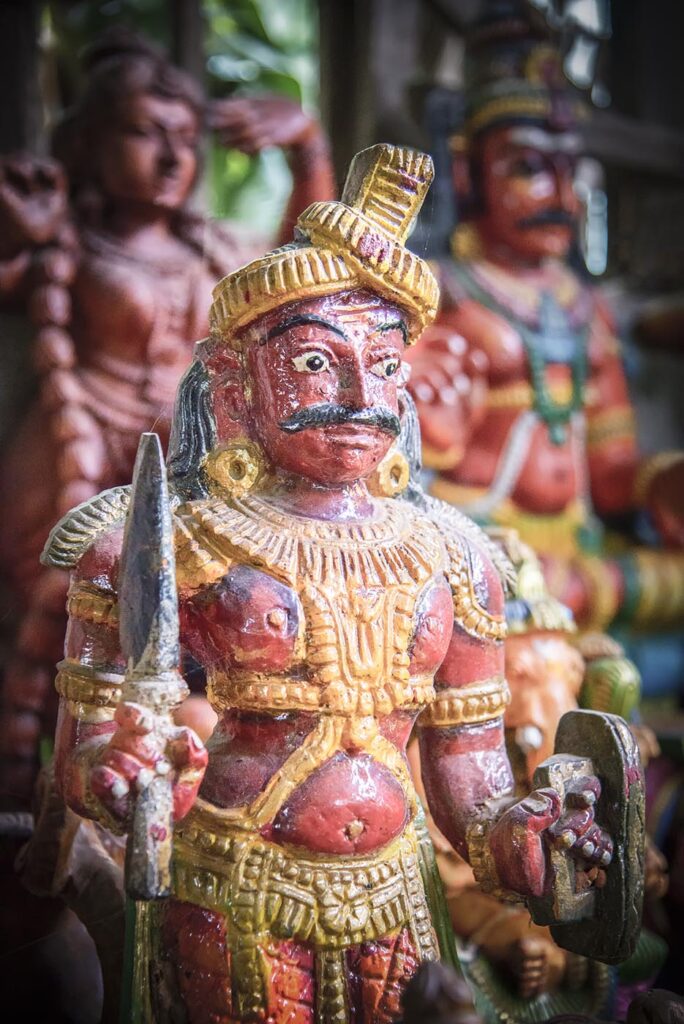
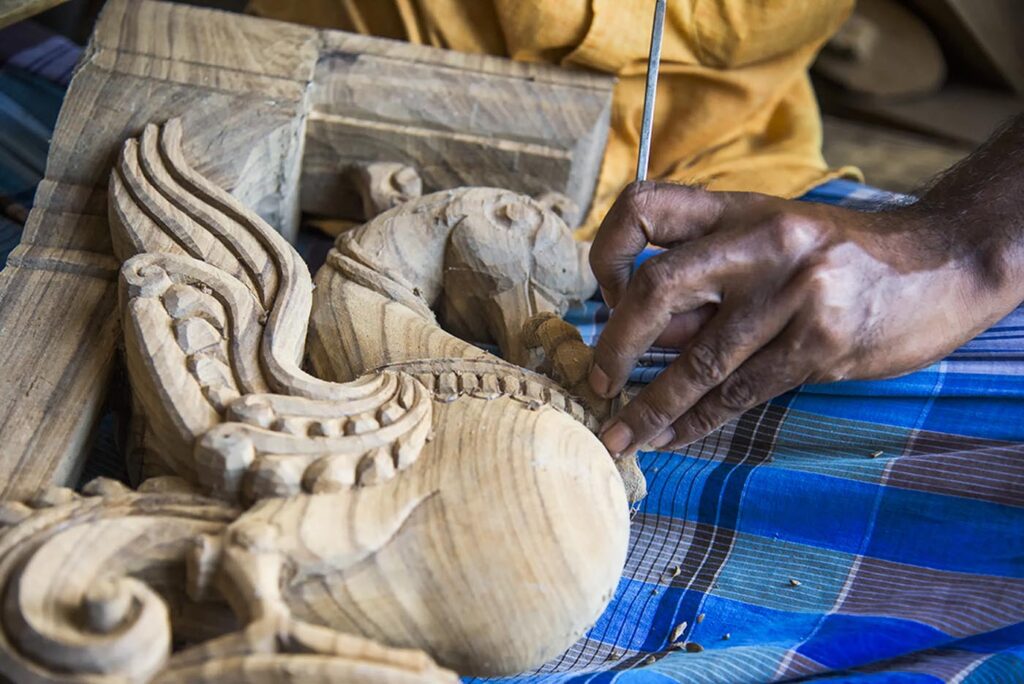
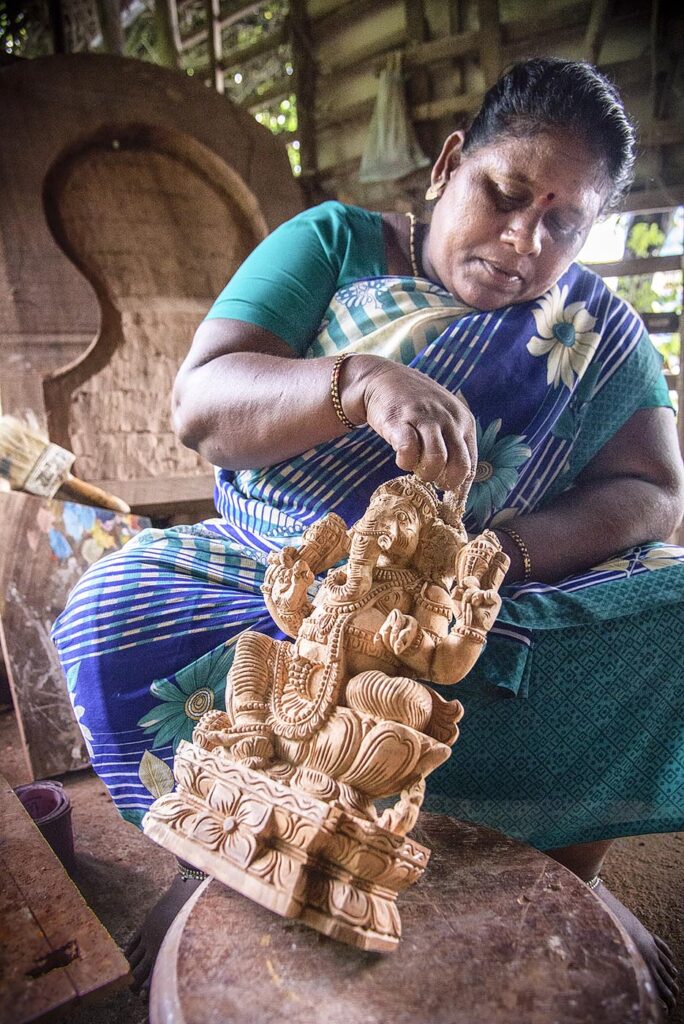
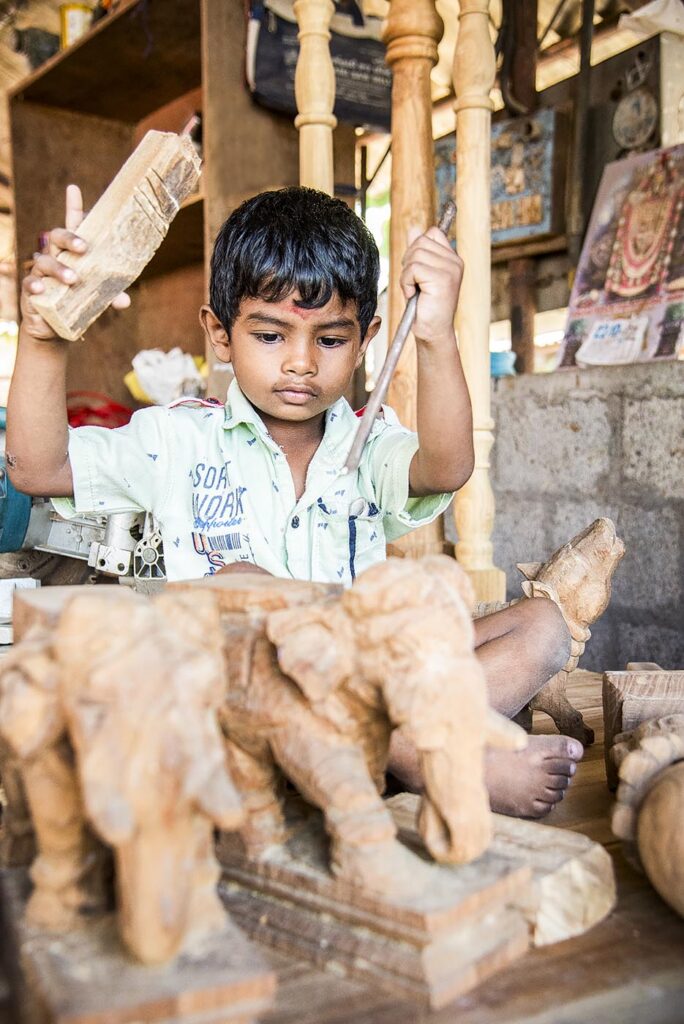
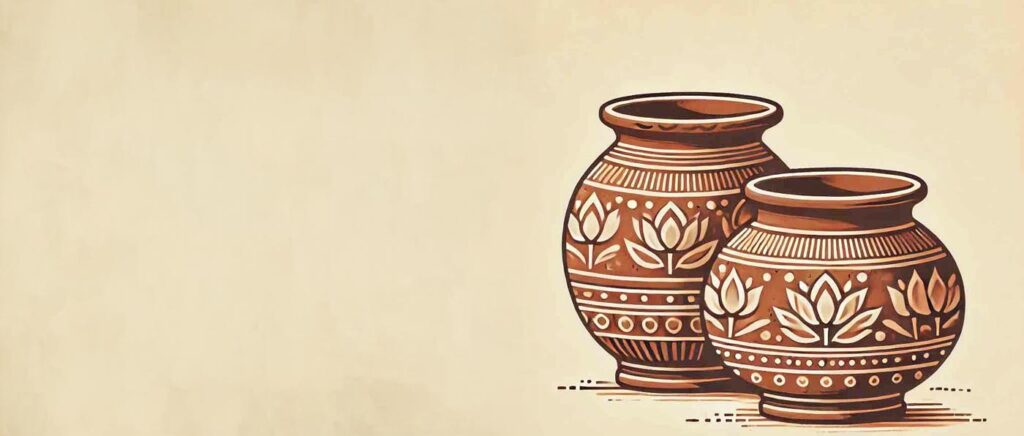
TERRACOTTA
The earth has been a medium of artistic expression since ancient times. Baked or burnt earth, called terracotta, is a popular material to create sculptures, plaques, and other objects of worship across civilizations. In India, artisans still create baked-earth Deities that resemble figurines from the Indus Valley relics. Terracotta figurines play a key role in rural rituals in the culturally rich state of Tamil Nadu. Archeological findings of terracotta pots, figurines, etc., from Arikkamedu, Urayiur, and Tirukampuliyur in the state are testimonies to the long-standing tradition. This archaic art is still alive in terracotta hubs, such as Villianur, Madurai, Tiruchirapalli and Coimbatore. We explored the craft as practiced in Villianur.
Significance in Tamil Nadu
On rural roads in South India, massive figures of vibrantly colored local Deities stand tall near paddy fields, ponds, river banks and at the borders of villages. With swords, machetes, tridents, sickles and whips, they are armed and ready to decimate any enemies trying to harm those under their protection. Made of terracotta, these figurines are deeply connected to the local culture, with roots in ancestral worship. This tradition of creating terracotta figurines for protection and prosperity continues in modern times.
While there were numerous local Deities in the past, currently only a few are worshiped regularly. Among them, Ayyanar and Mariamman are the most prominent. Found at the foothills of holy mountains and temples, their blessings are sought before entering the sacred places they guard. In Tamil Nadu villages, huge terracotta horses are offered to Lord Ayyanar in annual festivals called “Kuthirai Eddupu” or “Puravi Eduppu.” Votive offerings of these terracotta horses are called Ayyanar horses now. Individuals offer votives to express gratitude for wishes fulfilled, and communities offer them for prosperity and protection from calamities.
Villianur Terracotta Works
Sankaraparani River flows through the town of Villianur; the locals regard it as sacred. The riverbank is studded with many ancient temples, and the mud from the riverbed is rich in copper, aluminum and iron. The strength of the soil lends itself to building large terracotta artifacts. Villianur terracotta products have earned the government-issued Geographical Indication tag owing to the river, the soil and the craftsmanship they birthed.
We met celebrated artist V. K. Munusamy at his workshop, close to an old Siva temple. His infectious energy and passion are palpable. V. K. Munusamy is a 23rd-generation artist in a lineage of talented terracotta craftsmen. His parents, Krishan Pathar and Mangalaxmi, also award-winning artists, lived up to 100; their picture adorns the walls of his workshop. His wife and daughters specialize in creating clay miniatures, and his son is pursuing a Masters in Fine Arts in London.
Munusamy says he has loved making horses since he was a child. His dream is to keep making taller and taller horses and other sculptures as long as he lives, till 100 like his parents.
Creating terracotta objects can be a form of religious ritual or meditation, connecting the artist to the Divine. Munusamy compares creating a terracotta murti to laya (“merging”) yoga. “It takes patience and concentration, and you have to keep the image of the God you are making in mind all the time. Then your hands move.” He says the five elements, pancha bhuta, have to cooperate and bless the process; only then can we create a sculpture from the mud. As we break down the process, the interplay of elements becomes clear.
The Elements of Sculpture
Earth: Mud is collected from the river banks. Three types of soil from the river bed are taken; each is visibly different. The mud is sifted to remove fine stones and mixed with sawdust, paddy husk and straw. In the olden days, elephant dung was added. The mixture ferments for fifteen days.
Water: Water is added to the mud. Locally called mannu mithithal, the lumpy mud is stomped by men to make it smooth and pliable, like how dough is kneaded by hand for a perfect loaf of bread.
Mud to Figures: Prepared clay is molded into desired shapes by hand. Potter’s wheels are used in some places. In Villianur, artisans use coiling and pinching techniques that bring to mind a building emerging from the ground, inch by inch. The bigger figures are molded in parts and assembled at the time of installation. This makes transportation easier. Previous generations of artists camped near temples while building larger statues and went wherever their work took them.
Air drying: Smaller figurines, jewelry and lamps are left to dry naturally. Larger statues are dried and fired.
Fire and air: Larger figurines are baked in an open wood fire to strengthen and stabilize them. Logs of tamarind trees, cow dung, coconut shells and fronds are used. Firing is crucial: overheating can break the figurines, while underheating makes them fragile.
Air and ether: Under the sky, baked sculptures are extracted carefully and left to cool in an open space. “Mixing the clay is physically tiring work. We can’t do anything the next day,” says Munusamy. He and his team prepared 100 tons of clay to make 25-foot terracotta figurines of Chelliamman and other local Deities at Tiruvachiyur. This is a record of sorts. But he finds it hard to get labor nowadays. He believes that developing a machine for mannu mithithal could ease the process, reducing time and labor. However, this innovation may also raise questions about the impact on traditional artisanal practices.
“We watch. And we do,” Munusamy says. The symbols of each God and Goddess, their weapons, expressions on faces and stance are learned from childhood. The aesthetics and proportions are intuitive. “I did not study these in school. I learned by observing the sculptures in the temples, by watching people making them.” He fondly recollects watching his father and making miniature clay figures as a child. He wants to pass on that magic of handcrafting to children. In his training sessions they play with mud and make toys and whistles. At his workshop the tools are rudimentary, and great skills are needed to create forms out of a handful of clay. “Only fingers, hands and a stick—it is totally handcrafted,” he says with pride.
As we watch, Munusamy deftly wields his hands. Within minutes, the lump of clay becomes a face, and as he rolls and plasters a little clay on the face, it becomes a man with a mustache. In the next few seconds, the face gets two protruding teeth and it becomes a fierce face; a demigod is born. Miniature figures are made directly from the clay. Due to their cost effectiveness and portability, they are created in large numbers. Heads of Buddha and political figures such as Mahatma Gandhi and Ambedkar are in demand. During festivals such as Ganesh Chaturthi, Vinayaka statues are in high demand. This kind of seasonal demand is the primary source of income for traditional potters.
Kindling Flames of Learning
Munusamy’s speech is peppered with quotes from Tamil poet-saints Auvaiyar and Thiruvalluvar, who laid down rules for corporal and spiritual lives. Their philosophy emphasizes the importance of spreading knowledge, which inspires him to freely and passionately share his expertise in the craft and local culture. He has trained thousands of students, teachers and unemployed youth in India and worldwide. He believes India’s traditional crafts can be a great source of employment.
He has collaborated with Kota tribes in the hills of Nilgiris in Tamil Nadu to make their pottery commercially viable. He regularly works with self-help women’s groups to train them. He stresses the need for self-reliance, learning new techniques and responding to new opportunities. He also works with brass, fiberglass and other materials using molds. He hopes his son will introduce modern techniques and help him transform Villianur into a hub for terracotta art training and production.
As with woodcarving, efforts to promote and preserve this craft include fairs, exhibitions and educational programs. The central and state governments award artisans. They are huge morale boosters for the craftsmen, many of whom painstakingly work on their masterpieces for months to showcase their talents.
Challenges and Future
Urbanization is posing significant challenges to the preservation of local cultural practices, such as the annual renewal of Ayyanar horses, which were once a vital part of village life. Cement murtis are fast replacing clay ones. Munusamy asserts, “It is a misconception that cement lasts longer. Terracotta figures last for thousands of years; cement will start deteriorating after seven years.” Artisans face difficulties in finding raw materials and skilled labor. Growing concerns about extracting mud from rivers and around ponds have led to restrictions. Traditionally, potters had hereditary rights to areas of village commons where they could source clay, but shifting attitudes toward land ownership and perspectives on common resources are challenging that. As a result, the main raw material has become scarce and costly.
Timeless creations fashioned from earth
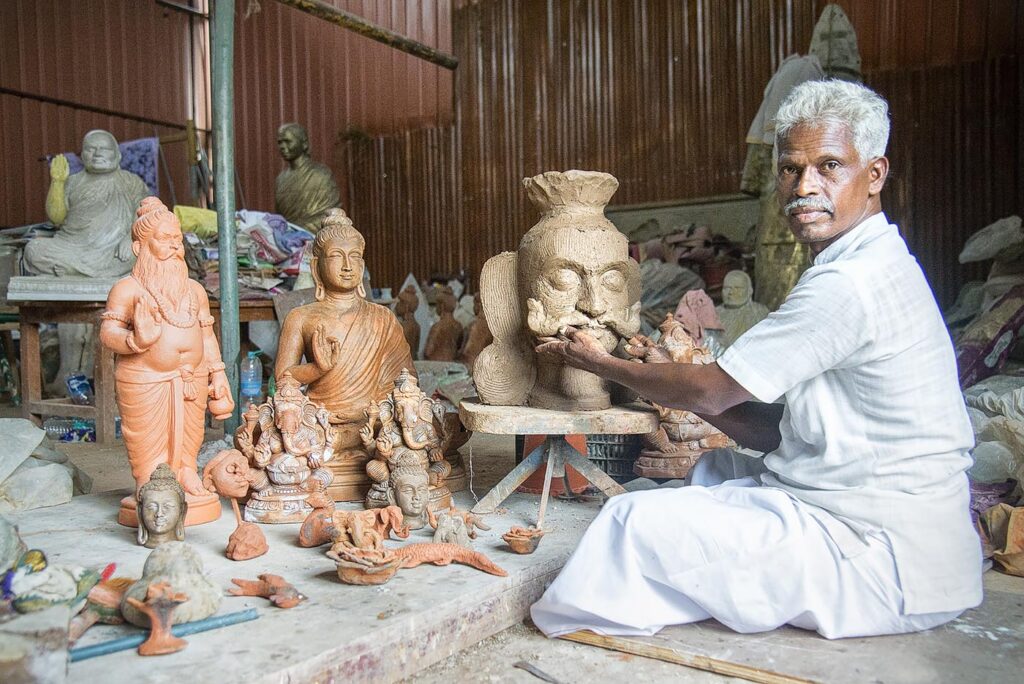
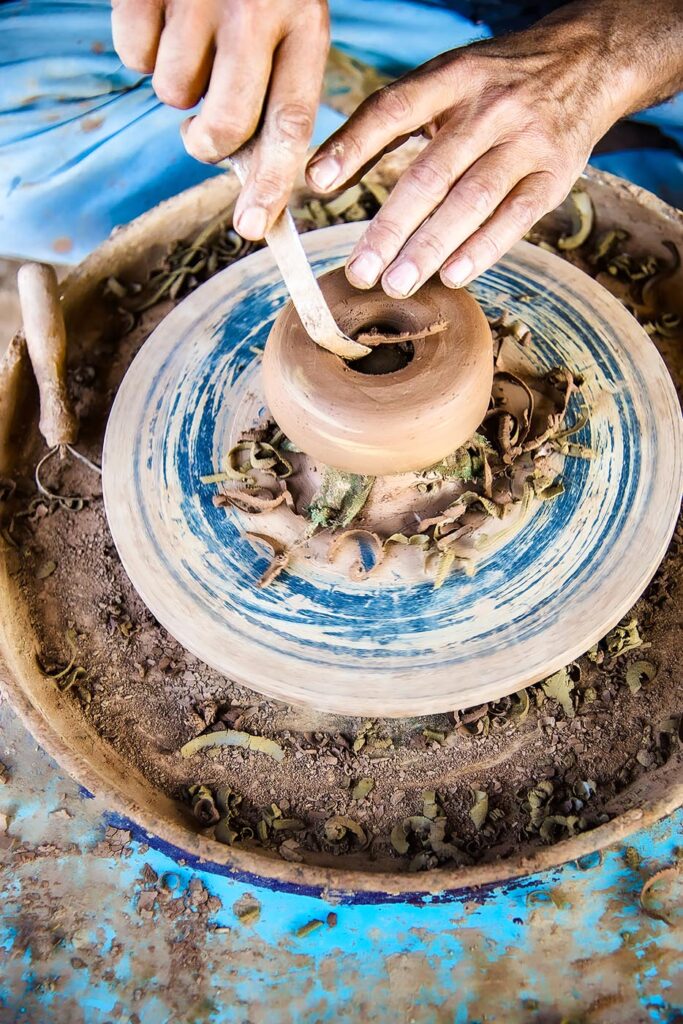
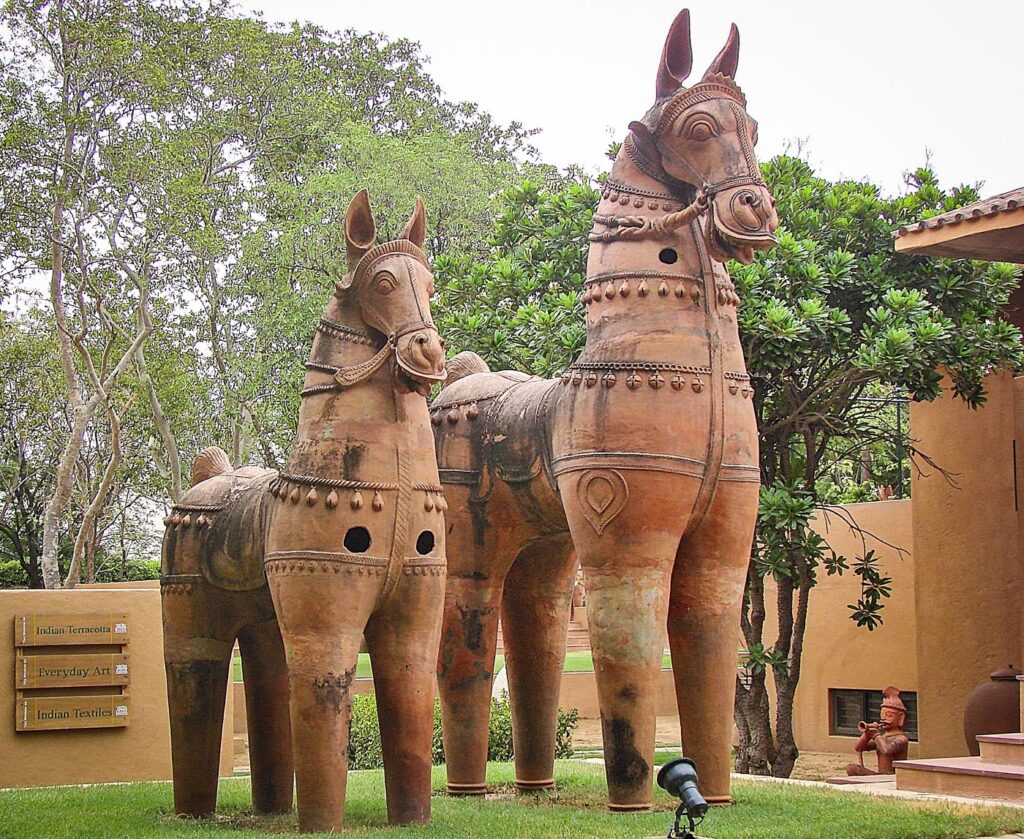

MUSIC
Gods are often depicted with instruments: Krishna with a flute, Siva with a drum and bull horn, Saraswati with a veena, Ganesha with a drum, Shakti with a hourglass hand-drum and Vishnu with a conch. Each instrument symbolizes a nuance of Divinity, and mystics interpret their music as levels of consciousness. Kailaya Vathyam, or Siva Vathyam, is an ensemble of ancient instruments more than 2,000 years old still played at Siva temples, predominantly in South India. They are played during all manner of religious events: festivals, consecrations, processions and whenever Thevaram or Thiruvasagam are sung.
Myths connect the instruments to Lord Siva: Brahmathalam, cymbals, was given to Brahma by Siva. The Panchamuga Vathyam, a drum with five faces, represents Siva’s five faces. The Rudra Veena was invented by Ravana, who plucked his veins to create music to appease Siva. Siva broke the hourglass drum, Udkai, to create Parai, the frame drum. He gifted Thiruchinnam, a brass wind instrument, to Saint Sambandar. The bull horn, His favorite, adorns His hip.
Types of Instruments
The Kailaya Vathyam ensemble employs three main categories: membranophones, brass percussion and brass wind instruments. Two other groups are strings and conches.
Membranophones (drums): Around 200 types of unique drums form the backbone of ancient Tamil music. Barrel, hourglass and frame drums play significant roles. Drumming is not for the faint of heart. Large Kailaya Vathyam drums are strapped to the shoulders of musicians when they play, and they can be heavy. Guru Vamadevan Janardan says,“Playing Thimilai (an hourglass drum played with fingers) is grueling. The fingers swell up and you can’t wear your rings afterward.” But it’s his favorite instrument to play!
Nowadays plastic is often used instead of hides, though Kosainagaran Sivakumar, a well known Kailaya Vathyam guru from Chennai who heads the Kosainagaran Group, insists on using animal hides. “From plastic, we get only sound, no music, no natham.”
Brass: Cymbals, gongs and bells add rhythmic accents and metallic tones to the ensemble. The heavier the cymbals, the better the sound. Student Ashwini likes to play a set that weighs three kilograms, “It is like a workout. Of course, the next day the hands hurt. But I love the resonating sound.”
Wind: Natural harmonics are provided by brass wind instruments—horns, archaic trumpets and bugles, along with conches, and the tharai, made of long brass pipes with circular bases Instruments like Thiruchinnam, Kutta Tharai and Nedun Tharai create majestic sounds that can be heardtwo kilometers away.
These instruments have no holes or valves to control air flow; relying on incredible skill and breath control to produce different notes. They are played by the movement of the lips. Siva Kanikavel says, “It is difficult to play Nedun Tharai and Kutta Tharai. After a few minutes, we have to stop.” In the orchestra, musicians take turns to maintain a continuous melody.
Strings: The Yaal and Veena were mentioned by saint Karaikal Ammaiyar in her ancient poems, but these are not part of Kailaya Vathyam, as their soft tone makes them impractial for processions.
Seashell instruments: The ever ubiquitous conch horn is blown to invoke the attention of the Gods and devas. Sivakumar noted its use in three rites of passage: “First, during infancy, a newborn is fed milk and honey through a small conch; second, the conch is played at weddings; and third, it is sounded at funerals.” Conches are blown in different ways as befits the occasion: held sideways to announce war, pointed downward at funerals, and pointed toward the sky for temple events.
Practical Challenges
Transporting and storing instruments is challenging. Some are huge, and all are delicate. Even a slight dent in the metal or a tear in a drum head can be tragic. Hence they require a lot of proper storage space. Artists often give them to their students to avoid the burden of transporting them from place to place.
The music of the Kailaya Vathyam essemble is bold and majestic; announcing to the world, far and wide, the arrival of kings and Gods. Playing them in the city can raise objections, as they are loud and offensive to some ears. Sivakumar says, “Over time we’ve stopped listening to strong sounds (valisai) like we did before, whether it was the sound of an elephant’s trumpet or the sound of drums; they are not part of our life anymore. The big sounds of Kailaya Vathyam could make even an injured soldier get up and fight. They had life. That sound was life. It was God. We have become too weak and cannot tolerate such sounds. Your neighbor will complain if you play at home.”
Temples as Custodians
In literature it is evident there were hundreds of instruments in the ancient Tamil land. During the Chola period, the number of Kailaya Vathyam had reduced to 70, and only about thirty are in use nowadays. Of these instruments, only five to seven are played in the temples.
Ancient temples in Tamil Nadu each have a chief musical instrument for initiating sacred routines such as puja, procession and festivals. For example, the temples at Chidambaram and Tiruvarur play the suda mathalam, a large version of mridangam. And the tharai horn is played at Ekambareshwar temple in Kanchipuram.
Ritualistic musical performances at temples follow a structured pattern, with the sound of the instruments signaling to those outside the temple what’s happening inside. As the Deity’s procession progresses, the music changes accordingly.
The Journey of Musicians
For the musicians, playing Kailaya Vathyam is more than playing music; it is a spiritual journey. As Saiva initiates, music is a divine offering to Siva and a way to experience Him. Every musician we spoke to had a fascinating story to share. Sivakumar was a regular office worker until he heard the Vathyam at Thiruvaiyaru thirty years ago. On that holy day, the music impelled him take off his shirt, smear himself with holy ash and dance. His journey into sacred music led him to various places to train and become a devout Saivite. In 2008 he quit his job after his guru’s demise and dedicated himself to playing and propagating ancient Tamil music.
In order to touch any of the instruments, one has to become a devotee of Siva, which means wearing a rudraksha, smearing holy ash on sixteen places on the body, becoming a vegetarian and performing puja to the Sivalinga twice a day. Many artists have become more serious about their spiritual life after getting initiated into Saivisim. Their paths to music vary. Some are captivated by reading Thevaram and Thiruvasagam, while others are struck by the music at temples and want to play.
Shanthi, a middle-aged woman, was spellbound by temple music four years ago: “The first time I heard it, I became a slave to the sound. I just wanted to play the instruments they were playing.” She found her guru, Vamadevan Janardan, in Chithalapet, near Chennai. Now she performs with him at temples. Ashwini was learning holy texts as a college student, when she heard about a music training program. She signed up and has been playing now for eight years.
Whether it is the music alone or the connection with Siva through the music, musicians are captivated and see it as the divine will. They simply submit to it. Experienced ones do not distinguish between music and Siva. Siva comes to them through music and they reach Siva through their music.
Primordial Instruments of the Gods
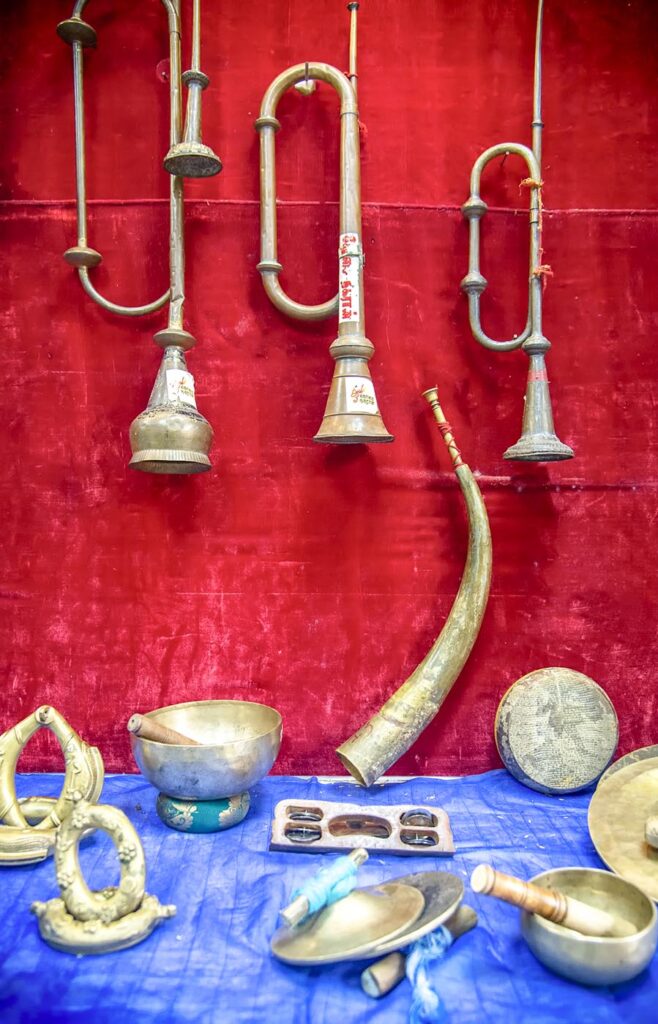
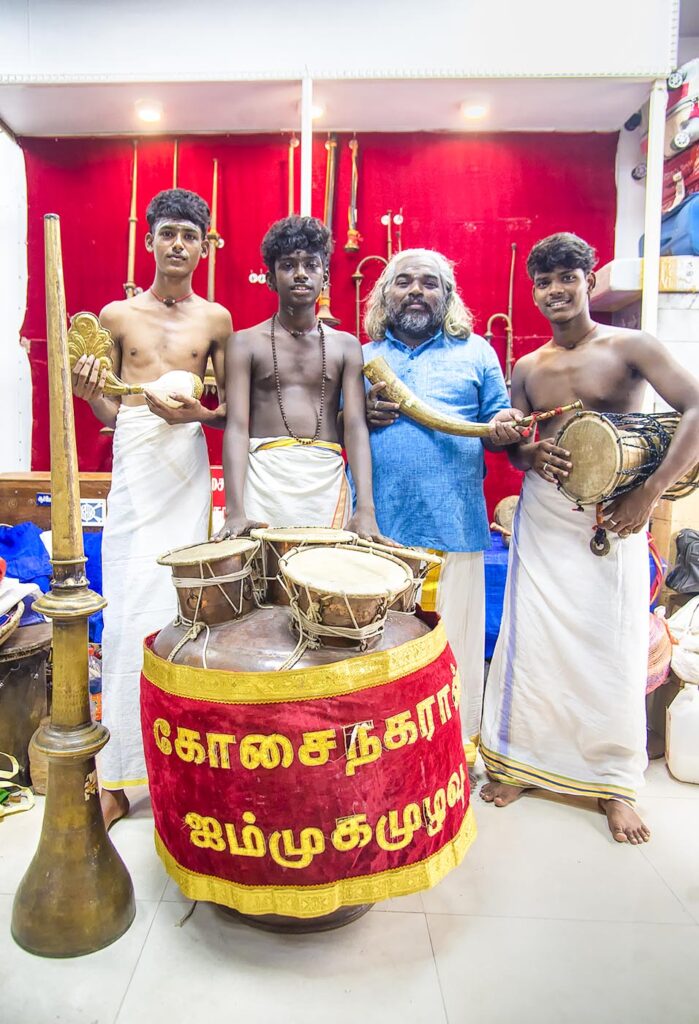
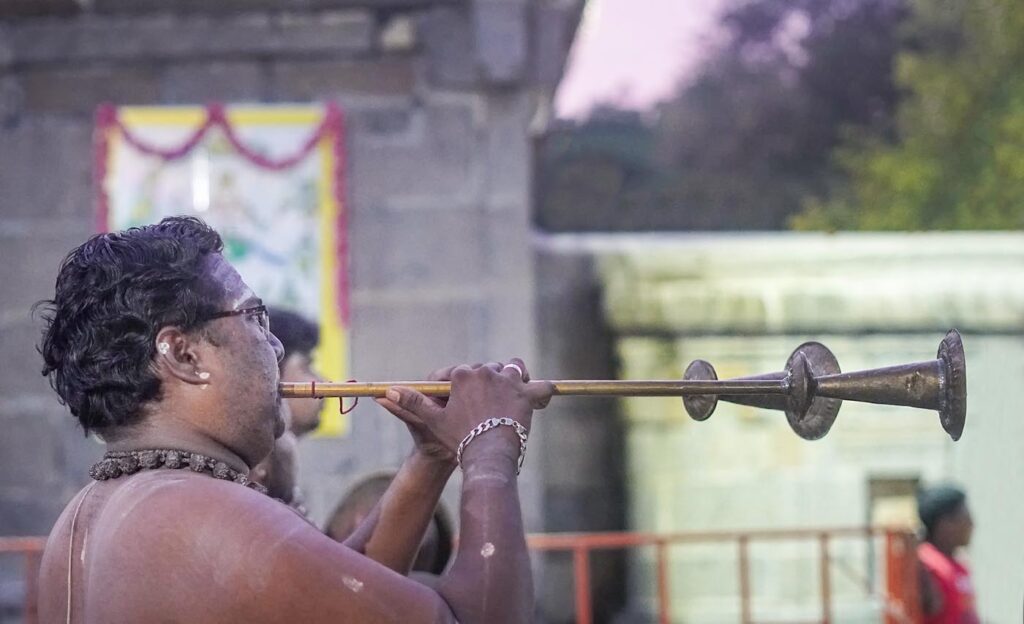
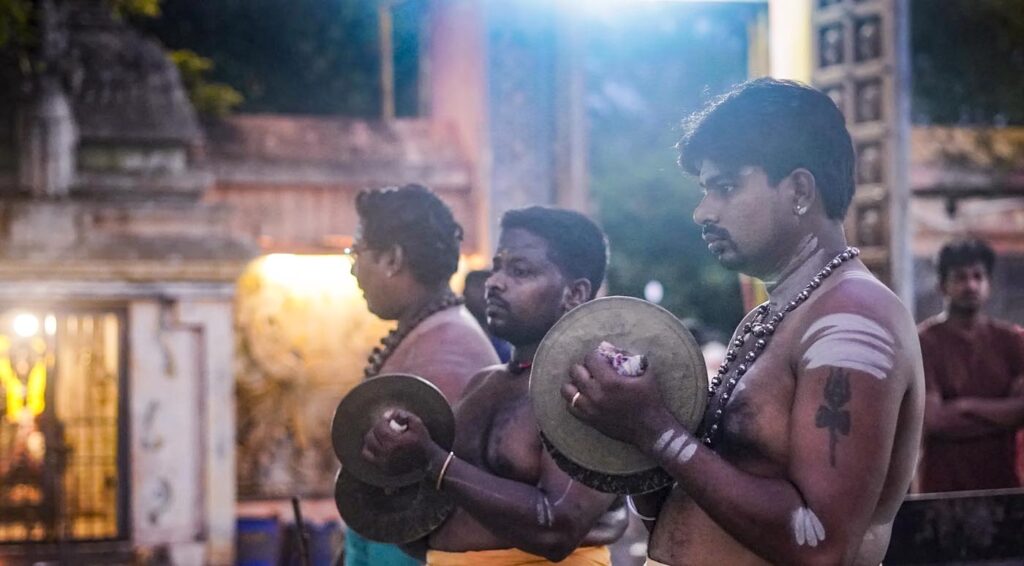
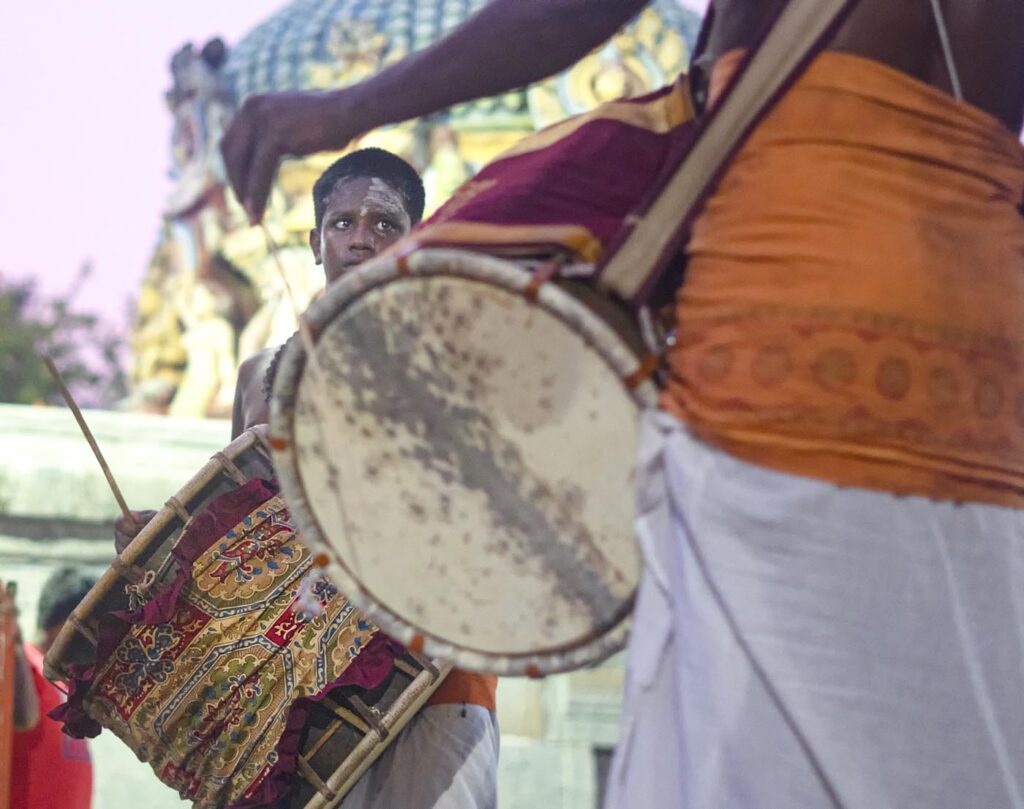
About The Author

Padma Krishnan is an independent journalist living in India. A certified hatha yoga teacher, she is passionate about exploring commonalities in ancient mystical traditions.

Anne Petry is a French photo-grapher focusing on Indigenous populations. Her nomadic life takes her all over, from the Shamans in Amazonia to the Hindu priests in India. She is passionate about people who keep alive their beliefs and traditions. Contact Instagram: annepetryphotography
